________________
The Tradition of Stupa in Jainism
68 I)
63
The same story is available with minute changes in Hariśena's Brhatkathā-kośa67 (Vairakumāra Ākhyāna), Somdevasuri's Yasastilaka campu68 (Vajrakumāra story in sixth Āśavāsa) and V. T. Kalpa.
The author of 'Yaśastilaka campu' narrates the story of erection of the stūpa with a little change. In Mathura, there was a king named Putikāvāhana. His first wife, Urvilla, the queen, was a follower of Jainism. At that time one Buddhist monk brought up an orphan girl to their monastery as acquainted with the prophecy that her destiny was to be the chief queen of the king Putikāvāhana. After few years, she grew up as a charming and beautiful lady. When the king saw this young lady in the Buddhist monastery, he did marry her, but after promising her to be made his chief queen. Once, the first queen, Urvilla, wanted to send a Jaina ceremonial chariot in the city for an eight-day procession as usual. But she could not do so, as the new chief queen used her influence to stop the Jaina procession in the city. The new queen organized another festival in honour of Buddha instead of the usual procession. Urvillā immediately approached the Rși Somadatta to inform him about the situation. The sage promised to do the needful for the continuation of the old practice. He called his disciple, Vajrakumāra, who was his son before renunciation and requested to use his magical powers for the continuation of the practice of procession. Vajrakumāra used his Vidya and descended from the sky with a group of Vidyadharas carrying flags, mirrors, golden jars, chariots, horse carts and musical instruments and went to Uurvilla's palace. From there, they went around in the city for eight days, as is supposed to be the procession, and then erected a stūpa with the image of the Arhat. Since then, the shrine was known as 'Deva nirmita'.
Jinaprabhasūri describes the myth regarding the controversy over the right to the stupa with Vaiṣṇavas, Śaivities and Buddists in later period69. They all claimed their individual proprietorship. The dispute was over with intervention by some mediators of the city. They advised "Mā Kalaheha! (Don't Quarrel!), this is the 'Deva Nirmita Stūpa' so doubts
67 Vairakumara-kathanak - Brihatkathakosha (Harishen), (Bombay, Bharatiya Vidyabhavan, 1942), pp. 22-27.
Trans. Sundarlal Shastri, Varanasi, Yaśastilaka campu,.
II) Handiqui, K.K., pp. 415.
69 पहाए लोआ विबुद्धा तं थूभं पिच्छंति परुप्परं कलहंति अ । केई भांति - वासुइलंछणो एस सयंभू देवो । अन्ने भांति - सेससिज्जा ठिओ नारायणो एस। एवं बंभ- धरणिंद - सूर - चंदाइसु विभासा । बुद्धा भांति न एस भो किंतु बुद्धंडउ त्ति ।
-V.T. Kalp, pp.17




